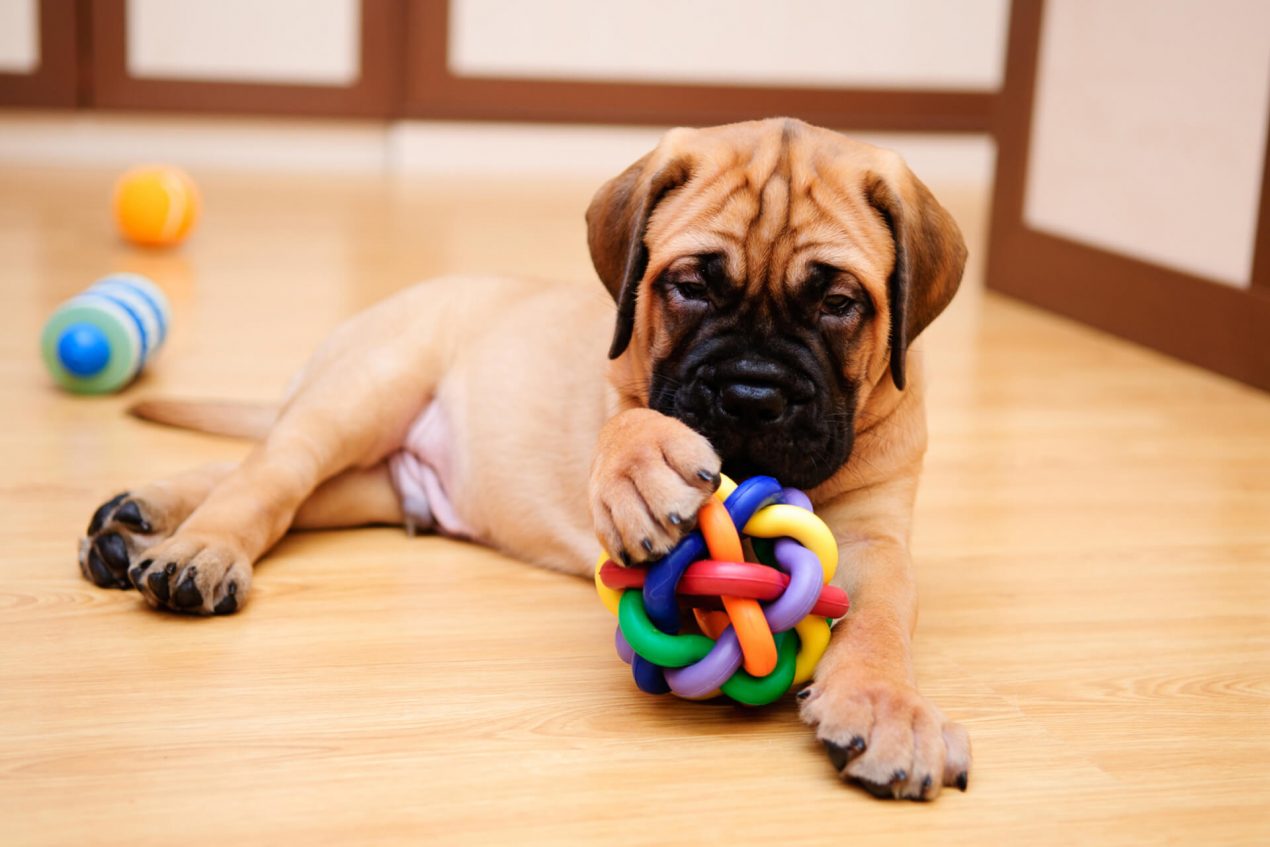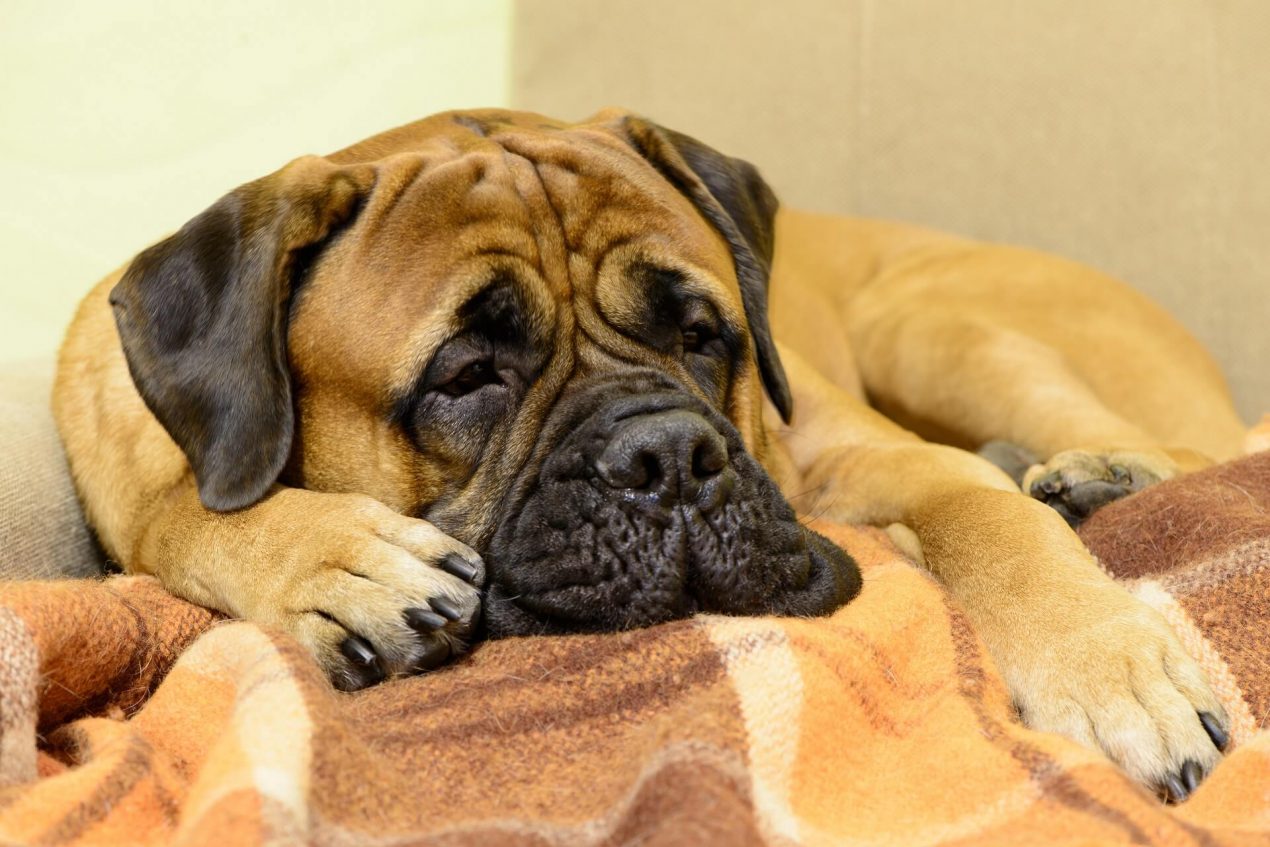With its powerful build and confident demeanor, the Bullmastiff makes an impressive presence. However, behind the massive facade lies an affectionate and gentle dog, known primarily for its calmness. In the profile, you’ll find all the information you need about the dog breed. 😉
History of the Bullmastiff
The Bullmastiff is a relatively young breed, only spreading in England since the 19th century. At that time, poor social conditions prevailed for the population, leading them to poach on the landlords’ lands. The landowners then hired gamekeepers to put an end to poaching, along with specially trained dogs. The dog had to be able to apprehend the poacher and hold him down without killing him. As a deterrent, the lawbreaker was supposed to be publicly hanged.
Thus, from a cross between the Old English Mastiff and the Old English Bulldog, the perfect guard dog for the gamekeepers emerged. Through ongoing selective breeding, the current appearance gradually developed. Initially, the English referred to the breed as the “Gamekeeper’s Nightdog.” On December 24, 1924, the English Kennel Club recognized this new breed under the name “Bullmastiff.” Around 1920, oil tycoon Rockefeller brought the first Bullmastiffs to the USA to guard his estate, and the breed slowly spread there as well. Throughout the 20th century, especially the police began to use the bulky dog as a service dog. However, it gradually found an increasing number of enthusiasts among private individuals. Internationally, it is classified into FCI Group 2, Section 2, Molossoids.
Breed Overview
GROUP: Working
HEIGHT: 24 to 27 inches
WEIGHT: 100 to 130 pounds
COAT: Short, dense coat
COAT COLOR: Fawn, red, or brindle with accents of black
LIFE SPAN: 8 to 10 years
TEMPERAMENT: Loyal, protective, alert, loving, companionable, calm
HYPOALLERGENIC: No
ORIGIN: England
Traits and Characteristics
The Bullmastiff is a balanced, highly people-oriented, and friendly dog. It is quite undemanding and adapts to its human pack in every situation. Although it may appear somewhat sluggish at first glance, it is a good watchdog and can independently assess whether there is danger or not. When excited, it does not start barking wildly but rather furrows its brow, giving a silent signal. The breed is considered very composed and has a strong self-confidence that cannot be easily shaken. The dog only submits to a strong and consistent person.
With good training, the gentle giant is usually very fond of children and, with successful socialization, has no problem with other dogs. The Bullmastiff is not frantic and also enjoys lying down with its owner on the sofa for a while. At times, the large dog even seems to forget that it’s no longer a puppy and cuddles up on its human’s lap despite its massive size.
| Affection Level | High |
| Friendliness | High |
| Kid-Friendly | High |
| Pet-Friendly | High |
| Exercise Needs | Medium |
| Playfulness | High |
| Energy Level | Medium |
| Trainability | Medium |
| Intelligence | Medium |
| Tendency to Bark | Medium |
| Amount of Shedding | Low |
How to Care for a Bullmastiff?
Considerations Before Getting One:
The decision to bring a Bullmastiff home should be long and well thought out. The breed generally suits only knowledgeable and experienced dog owners. In terms of care, the purebred dog is not very demanding and feels comfortable anywhere it is not alone. Family companionship is very important for its happiness.

If you’re absolutely certain that this breed is the right fit for you, the best way to find a reputable breeder is through the AKC (American Kennel Club) or the FCI (Federation Cynologique Internationale). For a healthy puppy from a good breeding, you can expect to pay up to $1000. If you don’t want to spend that much money and also want to do a good deed, consider visiting your local animal shelter. Here, you may often find a Bullmastiff in need of a loving new home.
Puppy Training and Development
The Bullmastiff puppy is an adorable companion, but it already requires consistent and non-violent training at a young age. If you don’t handle the puppy well, dealing with the fully-grown powerhouse will become even more challenging. Such a large dog with a strong protective instinct must be prepared from the beginning to be a reliable companion. Occasionally, depending on its mood, the Bullmastiff puppy can be a bit stubborn and headstrong.
In such cases, it’s up to you to gently and kindly persuade the puppy that working with you is fun. Stress and violence have no place here, as rewards achieve much more. If you need assistance with certain aspects, consider attending a dog training school. Here, the puppy can also interact with other dogs and learn social behaviors more easily.

Activities and Exercise
The Bullmastiff is generally a calm dog that doesn’t require above-average exercise. However, it enjoys daily walks in nature and enthusiastically participates in sports activities. Tracking work is particularly suitable for mental and physical stimulation for this breed. When out for walks, it doesn’t tend to wander off or roam and always stays close to its family to protect them if needed. The large, heavy dog is only moderately suitable for dog sports such as agility or obedience, as it prefers to do its own thing and never fully submits.
Interesting and Worth Knowing
Bullmastiff in Film and Television:
The most famous Bullmastiff in Hollywood was not a trained movie dog but rather the beloved pet of the Stallone family. Actor Sylvester Stallone owned a male named “Butkus,” whom he had to sell for only $50 due to financial problems. After his first screenplay was accepted and he achieved great success with the movie “Rocky,” he wanted his dog back. The new owner wasn’t very keen on the idea and only released Butkus for a proud $3,000. Stallone paid the price and then featured his dog in two “Rocky” films.
Do you also have a Bullmastiff or are you planning to get one soon? Tell me in the comments what makes the Bullmastiff so special to you.


